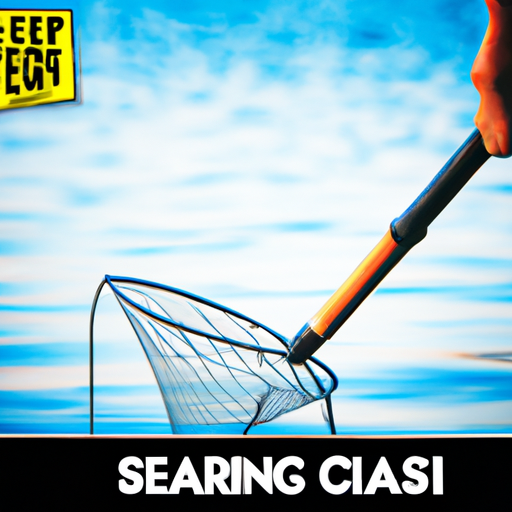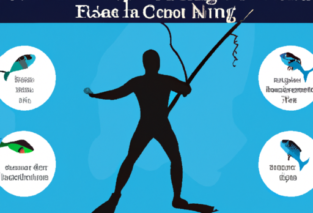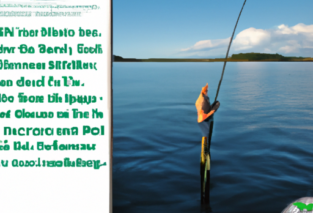If you’re an avid angler looking to cast your line and reel in some catfish this spring, look no further! Our product, “Can You Go Catfish Fishing in Spring: Essential Tips and Techniques,” is here to equip you with all the knowledge and skills you need to have a successful and enjoyable fishing experience. From understanding the behavior of catfish in the spring to mastering the best techniques and choosing the right bait, our comprehensive guide has got you covered. Get ready to make the most out of your spring fishing trips and land those impressive catfish catches!

Choosing the Right Equipment
Selecting the Right Rod and Reel
When it comes to catfish fishing in the spring, one of the first things you need to consider is the type of rod and reel you should use. Catfish are known for their strength and resistance, so it’s important to choose a rod with a strong backbone and a sensitive tip. A medium-heavy to heavy action rod is ideal for handling these powerful fish. As for the reel, a spinning reel or a baitcasting reel is a suitable choice, depending on your personal preference and fishing style. Make sure the reel has a smooth drag system to handle the unpredictable runs and powerful pulls that catfish are known for.
Choosing the Appropriate Fishing Line
Selecting the right fishing line is crucial when catfish fishing in the spring. Catfish are known for their sharp teeth and strong jaws, so you want a line that can withstand their powerful bites and make it through potential underwater obstacles. A braided line is a popular choice among experienced catfish anglers due to its strength and durability. It has a high pound-test rating and zero stretch, making it more sensitive to bites and allowing for better hook sets. Additionally, fluorocarbon leader material can be added to the end of the line to provide additional abrasion resistance.
Utilizing the Proper Hooks and Sinkers
Using the right hooks and sinkers is essential when targeting catfish in the spring. One popular choice among catfish anglers is a circle hook. Circle hooks have a unique design that significantly reduces the chances of gut-hooking the fish. The circle shape allows the hook to catch in the corner of the fish’s mouth, increasing the chances of a successful hook set. As for sinkers, using a variety of sizes and weights is recommended to help keep your bait at the desired depth. Egg sinkers and no-roll sinkers work well for catfish fishing, as they anchor your bait while still allowing movement in the current.
Understanding Catfish Behavior
Identifying Catfish Habitats
To increase your chances of success when catfish fishing in the spring, it’s important to know where to find these elusive creatures. Catfish are typically found in calm waters with cover and structure, such as slow-moving rivers, lakes, or reservoirs. They are known to seek out areas with submerged logs, root systems, or rock formations where they can hide and ambush their prey. Look for areas with good water flow, as catfish are attracted to the oxygen-rich environment it provides. Additionally, areas with a mix of deep holes and shallow flats are ideal spots to find catfish.
Knowing Their Feeding Patterns
Understanding catfish feeding patterns is key to a successful fishing trip. Catfish are opportunistic feeders and have a varied diet that includes live bait, dead bait, and even artificial lures. In the spring, catfish become more active as the water temperature rises, and they start feeding more frequently. They are known to feed both during the day and at night, so it’s important to be prepared for fishing at different times. Pay attention to the natural feeding cues of catfish, such as the presence of baitfish schools or the presence of feeding birds, to determine when and where to fish.
Recognizing Catfish Senses
Catfish rely on their senses to locate food and detect potential danger. Understanding their sensory abilities can help you become a more successful angler. Catfish have a highly developed sense of smell and taste, and they use their barbels, located near their mouth, to detect the scent of food. Using bait with strong smells, such as cut bait or stink bait, can be highly effective when targeting catfish. Additionally, catfish have a good sense of hearing and can detect vibrations in the water, so using rattling lures or incorporating noise into your bait presentation can help attract their attention.
Bait Selection and Presentation
Using Natural Baits
When it comes to catfish fishing, natural baits are often the go-to choice for many anglers. Catfish have a strong sense of smell and are attracted to the scent of fresh or decaying organic matter. Some popular natural baits for catfish fishing include live or cut bait such as shad, minnows, worms, or nightcrawlers. These baits can be presented on a hook with or without a bobber, depending on your preferred fishing technique. Experiment with different baits and determine what works best in your fishing location to increase your chances of success.
Opting for Artificial Lures
While natural baits are often the preferred choice for catfish fishing, artificial lures can also be effective in certain situations. Soft plastic baits, such as swimbaits or worms, can be rigged on a jig head and bounced along the bottom to imitate prey movement. Additionally, crankbaits and spinnerbaits can be used to cover larger areas of water and trigger reactionary strikes from aggressive catfish. When using artificial lures, choose colors that resemble the natural prey in your fishing area and vary your retrieve speed to entice catfish to strike.
Mastering the Art of Bait Presentation
The way you present your bait can make a significant difference in your catfish fishing success. When using natural baits, it’s essential to properly hook the bait to maximize its attractiveness to catfish. For larger baits, such as shad or cut bait, using a circle hook through the bait’s lips or behind its dorsal fin can increase your chances of a solid hook set. When presenting your bait, consider the water depth and structure you are targeting. Adjust the weight of your sinker, the length of your leader, and the distance from the bottom to find the optimal presentation for enticing catfish to strike.

Techniques for Spring Catfishing
Bank Fishing Techniques
Bank fishing is a popular and accessible method for catfish anglers of all experience levels. When bank fishing for catfish in the spring, look for areas with ample cover and structure nearby, such as fallen trees or submerged vegetation. Cast your baited hook into these areas and allow it to sit on the bottom, where catfish are likely to be foraging. Using a rod holder can help keep your rod secure while you wait for a strike. Alternatively, actively fishing by casting and retrieving your bait can help cover more water and locate active feeding catfish.
Boat Fishing Techniques
Utilizing a boat opens up a world of possibilities when it comes to catfish fishing in the spring. With a boat, you can explore different areas of the water body, target deeper sections, and adjust your fishing strategy as needed. One effective boat fishing technique is anchor fishing. Choose a spot with ideal catfish habitat, drop anchor, and cast your baited rigs around the boat. Another technique is drift fishing, where you let the boat drift naturally with the current while presenting your baits along the bottom. Experiment with different boat fishing techniques to find what works best in your fishing location.
Drift Fishing Strategies
Drift fishing is a versatile technique that can be effective when targeting catfish in the spring. This technique involves allowing your bait to drift naturally along with the current while you cover large areas of water. To drift fish for catfish, choose a location with a steady current and cast your baited rig upstream. Allow the current to carry your bait downstream, making sure to keep in touch with the bottom by periodically lifting and dropping your rod tip. Drift fishing can be done from both the bank and a boat, and it’s a great way to locate active feeding catfish.
Best Time and Weather Conditions
Determining the Optimal Fishing Time
Timing your catfish fishing trip correctly can greatly increase your chances of success. Catfish tend to be more active during specific periods of the day, such as early morning and late evening. These times are often referred to as the “magic hours” by experienced anglers. However, catfish can be caught throughout the day and night, so it’s important to adapt your fishing strategy based on their feeding patterns and behavior in your particular fishing location. Keep in mind that catfish tend to be more active and aggressive in warm water, so late spring, when water temperatures rise, can be an excellent time to target them.
Considering Water Temperature
Water temperature plays a crucial role in catfish behavior and feeding patterns. Catfish are ectothermic, meaning their body temperature will match the temperature of the surrounding water. In the spring, as the water temperature gradually rises, catfish become more active and start feeding more frequently. They tend to prefer water temperatures between 70°F and 80°F, although they can still be caught in colder water. Monitoring the water temperature in your fishing location and targeting areas with optimal temperature ranges can help increase your chances of catching catfish.
Accounting for Weather Conditions
While catfish can be caught in a variety of weather conditions, certain weather patterns can impact their behavior and feeding habits. In spring, catfish tend to be more active and responsive to bait during stable weather conditions. Periods of stable barometric pressure, mild temperatures, and minimal wind can create ideal conditions for catfish fishing. However, catfish can still be caught during less favorable weather conditions such as rain or wind. It’s important to adjust your fishing strategy accordingly and be prepared for changing conditions to ensure a successful fishing trip.
Navigating Catfish Fishing Regulations
Understanding Fishing Regulations
Before heading out for a day of catfish fishing in the spring, it’s crucial to familiarize yourself with the fishing regulations specific to your area. Fishing regulations can include rules and restrictions on bag limits, size limits, fishing methods, and seasons. These regulations are put in place to help protect catfish populations and ensure sustainable fishing practices. Check with your local fish and wildlife department or visit their website to obtain the most up-to-date information on catfish fishing regulations in your area.
Obtaining the Required Fishing License
To go catfish fishing legally, you will need to obtain the necessary fishing license. Fishing licenses are typically issued by state fish and wildlife departments and can be obtained online, at fishing and outdoor retailers, or through designated license agents. The cost of a fishing license can vary depending on your residency status, the duration of the license, and any additional endorsements you may need. It’s important to have your fishing license with you while fishing and to follow all applicable rules and regulations to ensure a positive fishing experience.
Respecting Catch and Release Practices
Practicing catch and release is not just a personal choice but an important conservation practice when it comes to catfish fishing. Catch and release allows anglers to target catfish without negatively impacting the fish population or the ecosystem. When practicing catch and release, it’s important to handle the fish with care to minimize stress and injury. Use appropriate fishing gear that enables easy hook removal, and consider using barbless hooks or circle hooks to further reduce harm to the fish. Additionally, avoid taking more fish than you need for personal consumption to help preserve catfish populations for future generations.
Tips for Beginner Catfish Anglers
Start with Basic Catfish Species
If you’re new to catfish fishing, it can be overwhelming to dive into the wide variety of catfish species out there. Start by targeting the more common and abundant catfish species, such as channel catfish or blue catfish. These species are widely distributed and can be found in various bodies of water, making them accessible to beginners. As you gain more experience and confidence, you can explore targeting other catfish species specific to your region. Starting with basic species allows you to learn the fundamentals of catfish fishing and build a foundation for future adventures.
Learn from Experienced Anglers
One of the best ways to improve your catfish fishing skills is to learn from experienced anglers. Seek out local fishing clubs, online forums, or social media communities dedicated to catfish fishing. Engage with other anglers, ask for advice, and share your experiences. Many experienced anglers are more than happy to offer tips, techniques, and valuable insights that can help you become a better catfish angler. Participating in fishing tournaments or attending fishing workshops and seminars can also provide opportunities to learn from knowledgeable anglers and gain hands-on experience.
Practice Patience and Persistence
Catfish fishing requires patience and persistence. Not every trip will result in catching a trophy-sized catfish, but that’s part of the thrill of the sport. Be prepared to spend long hours waiting for a bite, adjusting your fishing strategy, and experimenting with different techniques. Catfish can be unpredictable, and it may take some time to figure out their patterns and preferences in your fishing location. Don’t get discouraged by slow fishing periods or lack of immediate success. Enjoy the process, learn from each experience, and celebrate every catch, big or small.
Safety Precautions
Wearing Appropriate Safety Gear
Safety should always be a top priority when catfish fishing. Wearing appropriate safety gear can help protect you from potential hazards and ensure a safe fishing experience. When fishing from a boat, always wear a properly fitting personal flotation device (PFD) or life jacket. Ensure that your PFD is Coast Guard-approved and designed for anglers. In addition to a PFD, consider wearing a hat, sunglasses, and clothing that provides sun protection. Use sunscreen to protect your skin from harmful ultraviolet rays. It’s also important to have a first aid kit on hand in case of minor injuries.
Being Aware of Potential Hazards
Being aware of potential hazards while catfish fishing is essential for your safety. Catfish are equipped with sharp spines near their dorsal and pectoral fins that can cause painful injuries if mishandled. Exercise caution and handle catfish with care, using gloves or a rag to grasp the fish and avoid direct contact with the spines. Additionally, be mindful of your fishing surroundings. Avoid standing or casting near power lines or areas with obstructions that may entangle your line. Watch for slippery or uneven surfaces when bank fishing. By staying vigilant and aware of your surroundings, you can minimize potential risks.
Knowing Basic First Aid
Having a basic understanding of first aid can be valuable in case of minor injuries that may occur while catfish fishing. Keep a first aid kit in your fishing gear and familiarize yourself with its contents and usage. Learn how to properly clean and treat small cuts or hook wounds to prevent infection. It’s also important to know how to remove a hook from your own skin or a fellow angler’s skin safely. Basic first aid knowledge can make a difference in responding quickly and effectively to minor injuries, ensuring a safe and enjoyable fishing experience.
Conservation and Environmental Considerations
Avoiding Overfishing and Harvesting
Responsible catfish angling involves mindful practices to avoid overfishing and excessive harvesting of fish populations. It’s important to fish responsibly and adhere to catch and size limits set by local fisheries management authorities. Observe and respect any additional regulations specific to the body of water you are fishing in. Catch only what you need for personal consumption and release the rest to support healthy fish populations. By avoiding overfishing and limiting your harvest, you can contribute to the long-term sustainability of catfish populations and promote a balanced and healthy ecosystem.
Practicing Proper Catch and Release Techniques
To ensure the survival and well-being of released catfish, it’s crucial to practice proper catch and release techniques. When handling a catfish, wet your hands or wear gloves to minimize the removal of its protective slime layer. Support the fish with both hands, avoiding excessive squeezing or dropping. Remove the hook with care using a hook removal tool or needle-nose pliers, and get the fish back in the water as quickly as possible. If the fish needs time to recover, gently hold it in the water and provide support until it swims away on its own. Proper catch and release techniques contribute to sustaining healthy fish populations for future generations.
Preserving Natural Catfish Habitats
Preserving the natural habitats of catfish is crucial for their long-term survival. Pollution, habitat destruction, and invasive species pose significant threats to catfish habitats. As anglers, it’s essential to minimize our impact on the environment and take steps to preserve these habitats. Properly dispose of any trash or fishing gear, and pick up any litter you may find while fishing. Avoid damaging aquatic vegetation or disturbing sensitive habitats. Participate in community clean-up initiatives to help maintain the health and cleanliness of the water bodies where catfish thrive. By actively preserving their habitats, we can protect catfish populations for future generations to enjoy.
Conclusion and Final Thoughts
Catfish fishing in the spring offers an excellent opportunity for anglers of all skill levels to immerse themselves in the thrill of the sport. By choosing the right equipment, understanding catfish behavior, and mastering bait presentation techniques, you can significantly increase your chances of success. Timing your fishing trips based on optimal fishing times, water temperature, and weather conditions can help you maximize your catch. It’s important to navigate and adhere to fishing regulations, practice catch and release, and prioritize safety on every fishing excursion. By embracing responsible angling practices, respecting the environment, and sharing our knowledge, we can ensure the preservation and enjoyment of catfish fishing for generations to come. So grab your gear, head to your favorite fishing spot, and get ready to experience the excitement and joy that spring catfish fishing has to offer!





